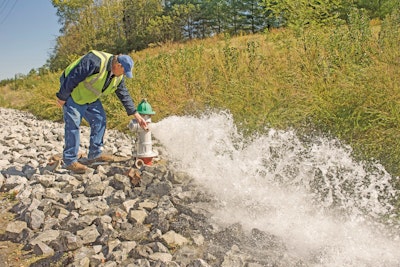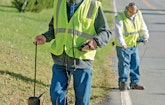Kingsport is a city of hills and ridges.
Nestled in the Appalachian Mountains of eastern Tennessee, it’s also a place where people want to live on the high ground. And that is the challenge for the city’s water distribution system.
“We had one customer who moved here from a northern state and complained about low water pressure,” says Chad Austin, P.E., manager of the distribution and collections systems for the city, on the Tennessee-Virginia border. “I pulled his meter, turned around, and said, ‘Boy this is a beautiful view.’ He said, ‘Yes, that’s why I love it here.’ And I said, ‘Well, that’s why you have low water pressure.’”
Over the years, the city has addressed those pressure problems with a series of booster pumps. Proof of how well the system has done can be found in its awards. In 2016, the distribution system earned an Operational Excellence Award from the American Water Works Association.
The team members running the city’s filtration plant are award winners in their own right. In 2017, they earned a ninth consecutive Directors Award from the Partnership for Safe Water.
Piping issues
When designing for distribution on the tops of ridges, the goal is to reach a pressure of 45 to 50 psi. The Kingsport system includes about 20 percent galvanized pipe, which fell out of favor with utilities because of corrosion issues. Another 20 percent of the pipe is cast iron, laid in 1929 when the system was started.
“We did a master plan a few years ago to identify areas where that pipe needs replacing,” Austin says. “We based our work on what our field staff found and also on issues reported by our customers. We try to take care of those in as timely a manner as possible. If there is a water-quality or flow issue, we move on those right away.”
Although the team has discussed the advantage of having alternate paths to feed water through the system, that’s not possible because of the topography. Elevation at the filtration plant is 1,286 feet, and the highest point in the system is 2,020 feet. “That’s why we have so many pressure zones,” Austin says.
The system’s 15 zones include a main pressure zone with five water tanks to serve the central city. Six main pumping stations are outside the city limits. In some cases, water must pass through three or four main stations to reach the far ends of the system.
Team approach
If a larger line has problems, the city has seven maintenance crews available, but Austin could not recall any major problems. There are enough interconnections to keep outages manageable. A big outage affects 200 to 300 people. With digital maps available on the technicians’ tablets, they can see where all the valves are and figure out which need to be closed to isolate a break and keep the size of an outage down.
Along with its main pumps, the system has 21 booster pumps. Main pump stations vary from 7.5 to 350 hp; most are in the 40 to 50 hp range. Booster pumps are typically 3 to 5 hp. In Austin’s 17 years with the utility, technicians have replaced about half of the booster pumps. Each time a station was replaced, engineers adjusted the design and, in some cases, the location to equalize the pressure through the zone.
Only two tanks are elevated to create head pressure. The rest are standpipes on the ridges; some of those also have booster pumps to supply water to buildings along the ridge. Tanks were sited to take advantage of gravity. There have been discussions about new tanks, but no one wants to give up land for them. Instead, the water team looks for operational efficiencies to eliminate the need for new tanks.
“Pressure is low along the ridges and high in the valleys,” Austin says. “One of the other challenges came in the late 1980s and early 1990s when we took over some smaller utilities and combined all the operations under one organization.”
Detecting leaks
One strategy for managing pressure is a continual search for leaks. When the city switched to an automated meter-reading system in 2008 and 2009, it also installed about 4,500 leak detectors. “So they’re sitting out there on services and turn on between 2 and 3 a.m.,” Austin says. “They listen for the sound of a leak. When the technician who’s reading meters drives through the area, the leak detector information downloads to his iPad along with the meter readings.
“A lot of our leaks don’t necessarily come up to the ground because we have a lot of karst geology. We’ve had several 6- and 8-inch lines break all the way through and not a drop of water came to the surface. We had to spot the pressure drop and then go look for them.” In one case, the customers having problems were more than a mile from the break.
Two employees survey for leaks in areas that have not been checked recently. “That helps us define some leaks that otherwise we wouldn’t have known about,” Austin says. “And it helps us be proactive because in other places, citizens have been very upset about the size of water losses they pay for.”
Preventing contamination
The city also implemented a cross-contamination program before Austin arrived, and in 2009, it won an award from the Tennessee Backflow Prevention Association.
Every customer is surveyed to determine what is present — swimming pools, water softeners, irrigation lines and other features — and how great a cross-contamination risk each presents. Kingsport is home to industries that include a paper mill, military ammunition plant and chemical plant. If there is a risk, technicians check to ensure that backflow preventers are installed.
The initiative started a couple of decades ago after an incident involving a trucking company that had a wash bay with a sump. The hose used to wash the trucks was lying in the sump one day when a waterline broke, and some of the oily, soapy wash water was sucked into the lines. Backflow preventers are tested annually. At the same time, a technician does another survey to find out whether anything has changed. New customers are surveyed when the tap is installed.
Looking for new customers
Kingsport has extra capacity in its filtration plant and has a tool to attract industries. The chemical plant is just downstream of the water system intake on the South Fork of the Holston River. Founded in 1920, the chemical plant makes products found in paint, adhesives, textiles, sports-drink bottles, pharmaceuticals, medical devices and other goods. The chemical plant has its own water intake for production processes and fire control, but potable water for employees comes from the city. The chemical plant accounts for about 15 percent of the system’s average daily production of 15 mgd.
“We want industries, especially if they use a lot of water,” Austin says. “With our system spread out the way it is, we can’t put a plant anywhere because we simply could not push enough water into some of those pressure zones. But there are good spots where a company would do well in proximity to our larger lines.”
The technical staff is a mix of ages and experience. About 30 years ago, the city hired a number of people, and in the past few years, several of them have retired. Austin’s section, which includes water and sewer, has 77 people. More than 20 have been with the city for 20 years or more. The same number have been on the team for fewer than five years.
The Kingsport team has a good handle on its system, but that isn’t enough. They’re working on data collection and analysis as part of the Partnership for Safe Water program. It will help Kingsport better handle all those ups and downs.
Technology in the field
Since 2014, water distribution technicians in Kingsport, Tennessee, have used iPad tablets to help manage the system. Before that, digital maps were available through the city’s GIS but were not accessible to technicians in the field.
“We manage all our work through iPads,” says Chad Austin, P.E., who manages the water distribution system. “If something is broken, a technician does a request that is tagged with the name of that asset. In the office, we can use that information to do reports and look at, for example, how often we have fixed a section of line.”
If a line is breaking often, it is moved up on the replacement schedule. Technicians are not limited to looking at waterlines. They can also see sewer and stormwater lines on iPad maps. It helps them understand the whole system so they can operate it better, Austin says. Also on the iPads are lists of what equipment is designated for a job, which people are assigned, their hours, and a material list.
Repair crew leaders carry the iPads and go out with technicians who read meters so they can see, for example, where service has been turned off. “I can open the software and see the status of any request,” Austin says. The Cartegraph operations management system on the iPads and office computers links to the city’s GIS system. Changes made to a map in one system are automatically updated on the other.
A few valves in the Kingsport system can be controlled from an iPad, but most are still manual. Also linked to the iPads are some pressure-reducing and flow-sensing equipment. Kingsport is working on an improvement plan from the Partnership for Safe Water. For the phases that require good recordkeeping and data analysis, the iPads will be helpful.










